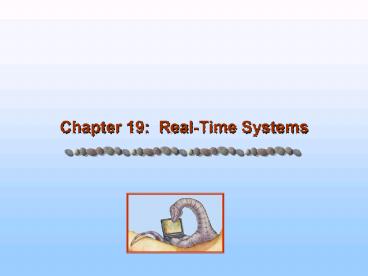Chapter 19: RealTime Systems PowerPoint PPT Presentation
1 / 26
Title: Chapter 19: RealTime Systems
1
Chapter 19 Real-Time Systems
2
Chapter 19 Real-Time Systems
- System Characteristics
- Features of Real-Time Systems
- Implementing Real-Time Operating Systems
- Real-Time CPU Scheduling
- VxWorks 5.x
3
Objectives
- To explain the timing requirements of real-time
systems - To distinguish between hard and soft real-time
systems - To discuss the defining characteristics of
real-time systems - To describe scheduling algorithms for hard
real-time systems
4
Overview of Real-Time Systems
- A real-time system requires that results be
produced within a specified deadline period. - An embedded system is a computing device that is
part of a larger system. (i.e. automobile,
airliner) - A safety-critical system is a real-time system
with catastrophic results in case of failure. - A hard real-time system guarantees that real-time
tasks must be completed within their required
deadlines. - A soft real-time system provides priority of
real-time tasks over non real-time tasks.
5
System Characteristics
- Single purpose
- Small size
- Inexpensively mass-produced
- Specific timing requirements
6
System-on-a-Chip
- Many real-time systems are designed using
system-on-a-chip (SOC) strategy. - SOC allows the CPU, memory, memory-management
unit, and attached peripheral ports (i.e. USB) to
be contained in a single integrated circuit. - SOC is typically less expensive than the
bus-oriented organization.
7
Bus-Oriented System
8
Features of Real-Time Kernels
- Most real-time systems do not provide the
features found in a standard desktop system. - Reasons include
- Real-time systems are typically single-purpose.
- Real-time systems often do not require
interfacing with a user. - Features found in a desktop PC require more
substantial hardware that what is typically
available in a real-time system.
9
Virtual Memory in Real-Time Systems
- Address translation may occur via
- Real-addressing mode where programs generate
actual addresses. (no virtual memory technique)
(P L) - Relocation register mode. (P L R)
- Full virtual memory (P)
10
Implementing Real-Time Operating Systems
- In general, real-time operating systems must
provide - Preemptive, priority-based scheduling
- Preemptive kernels
- Latency must be minimized
11
Priority-Based Scheduling
- Real-time operating system must response
immediately to a real-time process as soon as
that process requires the CPU. - The scheduler for a real-time operating system
must support a priority-based algorithm with
preemption.
12
Preemptive Kernels
- Nonpreemptive kernels disallow preemption of a
process running in kernel mode, a kernel mode
will run until it exits kernel mode, blocks, or
voluntarily yields control of the CPU. - A preemptive kernel allows the preemption of a
task running in kernel mode. - Preemption points are used to make a kernel
preemptible. - Preemption points checks to see whether a
high-priority process needs to be run. If so, a
context switch takes place. When high-priority
process terminates, the interrupted process
continues with the system call.
13
Event Latency
- Event latency is the amount of time from when an
event occurs to when it is serviced.
14
Interrupt Latency
- Interrupt latency is the period of time from when
an interrupt arrives at the CPU to when it is
serviced.
15
Dispatch Latency
- Dispatch latency is the amount of time required
for the scheduler to stop one process and start
another.
16
Real-Time CPU Scheduling
- Periodic processes require the CPU at specified
intervals (periods). - p is the duration of the period.
- d is the deadline by when the process must be
serviced. - t is the processing time.
17
Scheduling of tasks when P2 hasa higher priority
than P1
18
Rate Monotonic Scheduling
- Rate-monotonic scheduling algorithm schedules
periodic tasks using a static priority policy
with preemption. - A priority is assigned based on the inverse of
its period. - Shorter periods Higher priority
- Longer periods Lower priority
19
Rate Monotonic Scheduling
- Example
- The periods for P1 and P2 are 50 and 100
respectively. - The processing times are T1 20 for P1 and T2
35 for P2. - The deadline of each process requires that it
completes its CPU burst by the start of its next
period. - CPU utilization CU(P1) 20/50 and CU(P2)
35/100 - Total CPU utilization is 75 (not greater than
100)
20
Miss Deadlineswith Rate-Monotonic Scheduling
- Rate-monotonic scheduling
- Missing deadlines with rate-monotonic scheduling
whereP1 50 and P2 80
Deadline for P2
21
Earliest Deadline First Scheduling
- Rate-monotonic scheduling
- Priorities are assigned according to deadlines
- The earlier the deadline, the higher the priority
- The later the deadline, the lower the priority
22
Proportional Share Scheduling
- T shares are allocated among all processes in the
system. - An application receives N shares where N lt T.
- This ensures each application will receive N / T
of the total processor time.
23
Pthread Scheduling
- The Pthread API provides functions for managing
real-time threads. - Pthreads defines two scheduling classes for
real-time threads - SCHED_FIFO - threads are scheduled using a FCFS
strategy with a FIFO queue. There is no
time-slicing for threads of equal priority. - SCHED_RR - similar to SCHED_FIFO except
time-slicing occurs for threads of equal
priority.
24
VxWorks 5.0
25
Wind Microkernel
- The Wind microkernel provides support for the
following - Processes and threads.
- Preemptive and non-preemptive round-robin
scheduling - Manages interrupts (with bounded interrupt and
dispatch latency times). - Shared memory and message passing interprocess
communication facilities.
26
End of Chapter 19

